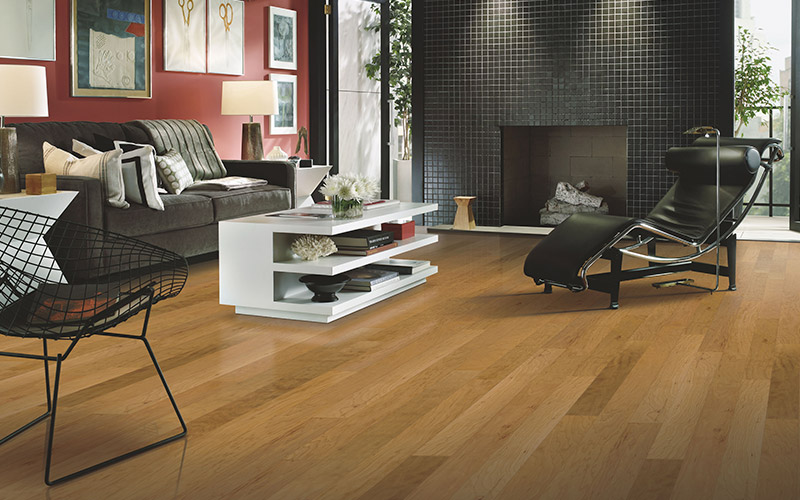Introduction:
Choosing the right flooring for your home is crucial, intertwining aesthetics, functionality, and budgetary concerns. Both vinyl and laminate flooring choices gained popularity due to their affordability and resilience. This detailed guide dives into the distinct features, advantages, and limitations of laminate and vinyl flooring, guiding you toward a well-informed decision that resonates with your preferences and budget. Laminate, predominantly crafted from compressed wood, mimics the elegance of hardwood at a more affordable price point. On the other hand, vinyl, being a synthetic material, boasts water resistance and a broad spectrum of design options. By understanding the strengths and weaknesses of each, you can ensure a harmonious blend of aesthetic charm, longevity, and utility for your home.
Understanding Laminate Flooring:
What is Laminate Flooring?
Laminate flooring is a synthetic material designed to mimic the appearance of natural materials like hardwood or stone. It’s composed of multiple layers, including a durable wear layer, a high-resolution printed design layer, a core layer for stability, and often a moisture-resistant backing layer.
Composition and Layers:
The composition of the laminate flooring store Scarborough makes it highly resistant to scratches, fading, and dents. The top wear layer protects against daily wear and tear, making laminate flooring suitable for high-traffic areas like living rooms and hallways.
Visual Realism:
Advancements in technology have improved the visual realism of laminate flooring, allowing it to resemble natural materials closely. This makes laminate an attractive option for budget-conscious homeowners seeking the look of hardwood or stone without the associated costs.
Exploring Vinyl Flooring:
Types of Vinyl Flooring:
Vinyl flooring has two primary forms: luxury vinyl tile (LVT) and luxury vinyl plank (LVP). LVT replicates the appearance of stone or ceramic tiles, while LVP imitates hardwood planks. Vinyl flooring can also be glued down, loose-laid, or floated, offering versatile installation methods.
Installation Methods:
Vinyl flooring’s flexible installation methods suit various spaces, including kitchens, bathrooms, and basements. Glue-down vinyl provides enhanced stability, while loose-laid or floating options allow quicker installation and potential DIY projects.
Style and Design Versatility:
One of vinyl’s standout features is its wide range of design options. It can emulate various textures, colours, and patterns, allowing you to achieve your desired aesthetic without sacrificing durability.
Comparing Laminate and Vinyl Flooring:
Durability and Longevity:
Both laminate and vinyl flooring offer impressive durability. The Laminate’s top wear layer is highly scratch-resistant, making it ideal for homes with pets and children. Vinyl’s ability to handle moisture and spills without warping contributes to its longevity.
Water Resistance and Moisture Tolerance:
Vinyl flooring is inherently waterproof due to its synthetic composition, making it an excellent choice for areas prone to moisture exposure, such as bathrooms and kitchens. Laminate is less water-resistant, so caution is needed to prevent water damage.
Maintenance and Cleaning:
Laminate flooring is easy to clean and maintain with regular sweeping and occasional damp mopping. Unlike hardwood flooring and you can also get this flooring from a hardwood flooring stores Scarborough. Vinyl’s waterproof nature allows for worry-free cleaning with water and mild detergents, making it suitable for busy households.
Comfort and Sound:
Laminate flooring can be noisier underfoot, but underlayment installation can help reduce noise. Vinyl’s softer surface offers better sound absorption and a more comfortable feel, especially in rooms where you spend extended periods.
Environmental Impact:
Both laminate and vinyl flooring have environmental considerations due to their synthetic composition. However, some manufacturers offer eco-friendly options prioritising sustainable materials and production processes.
Budget Considerations:
Upfront Costs:
Laminate flooring has a slightly lower upfront cost compared to vinyl. However, prices can vary based on brand, quality, and design. It’s essential to balance your budget with your desired aesthetics.
Lifespan and Replacement Costs:
While both options are relatively affordable, the lifespan and potential replacement costs are worth considering. Laminate flooring can last around 15-25 years, while vinyl can last up to 20-30 years, depending on quality and maintenance.
Return on Investment (ROI):
Upgrading your flooring can positively impact your home’s value. Both laminate and vinyl flooring offer decent ROI, making them attractive choices for homeowners looking to enhance their property’s appeal without overspending.
Installation Process:
DIY vs. Professional Installation:
Both laminate and vinyl flooring can be installed as DIY projects, especially with loose-laid or floating options. However, professional installation ensures a flawless finish, especially when dealing with complex layouts or intricate patterns.
Preparing the Subfloor:
A proper subfloor is crucial for the longevity of your flooring. Laminate can be installed over various subfloors, while vinyl might require more preparation, such as leveling uneven surfaces.
Installation Difficulty:
Laminate flooring generally requires more precision during installation due to its click-and-lock mechanisms. Vinyl’s flexibility can make installation easier, especially for beginners.
Choosing Based on Room:
High-Traffic Areas:
Both laminate and vinyl are suitable for high-traffic areas, but laminate’s scratch resistance might give it a slight edge in spaces prone to heavy foot traffic.
Moisture-Prone Spaces:
In areas with higher moisture levels, such as bathrooms or laundry rooms, vinyl’s waterproof nature makes it the preferred choice.
Aesthetic Preferences:
Your aesthetic preferences play a significant role in your decision. If you desire the look of hardwood or stone, laminate offers a realistic appearance. On the other hand, vinyl’s versatility in design and patterns can cater to a broader range of styles.
Conclusion:
In the laminate vs. vinyl debate, both options offer budget-friendly choices with their own set of advantages. When deciding, consider your specific needs, room requirements, maintenance expectations, and overall design preferences. By carefully weighing the pros and cons, you can select the flooring that best complements your lifestyle while staying within your budgetary constraints.








